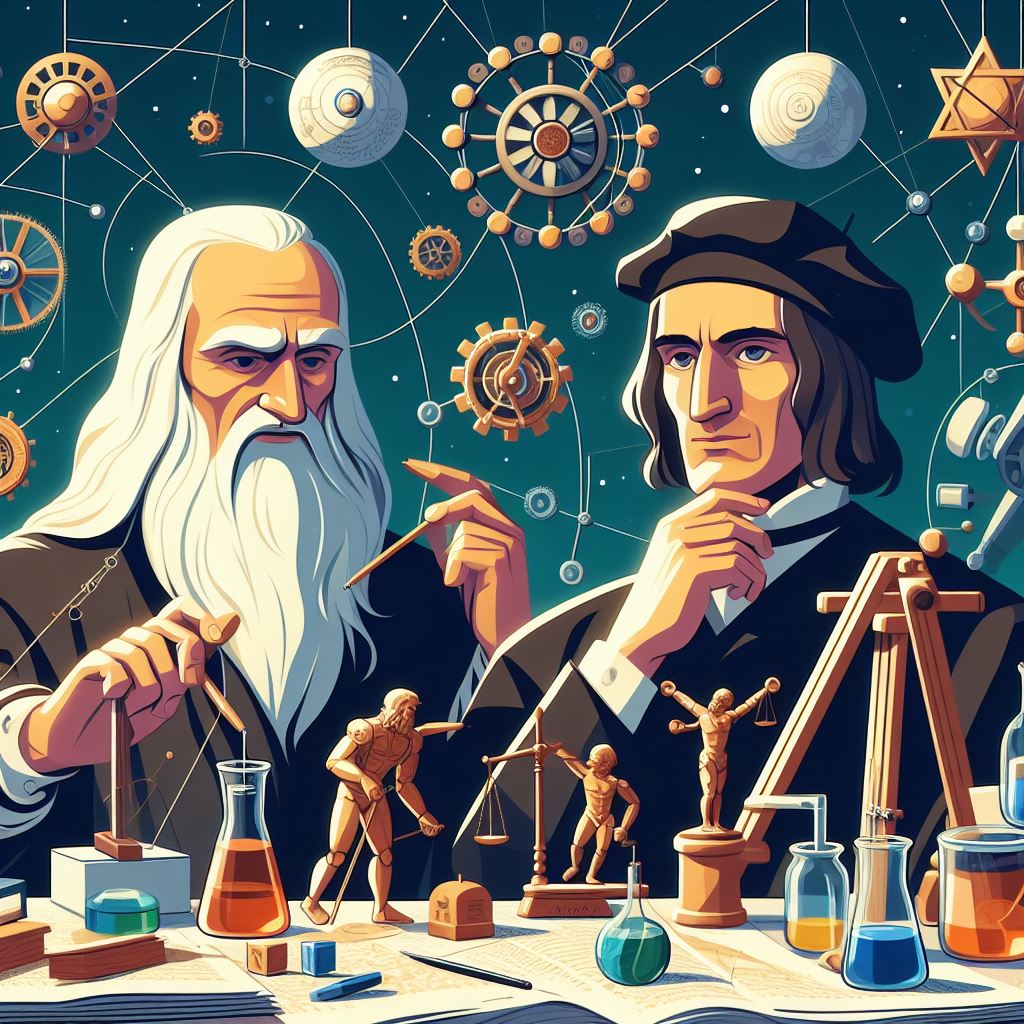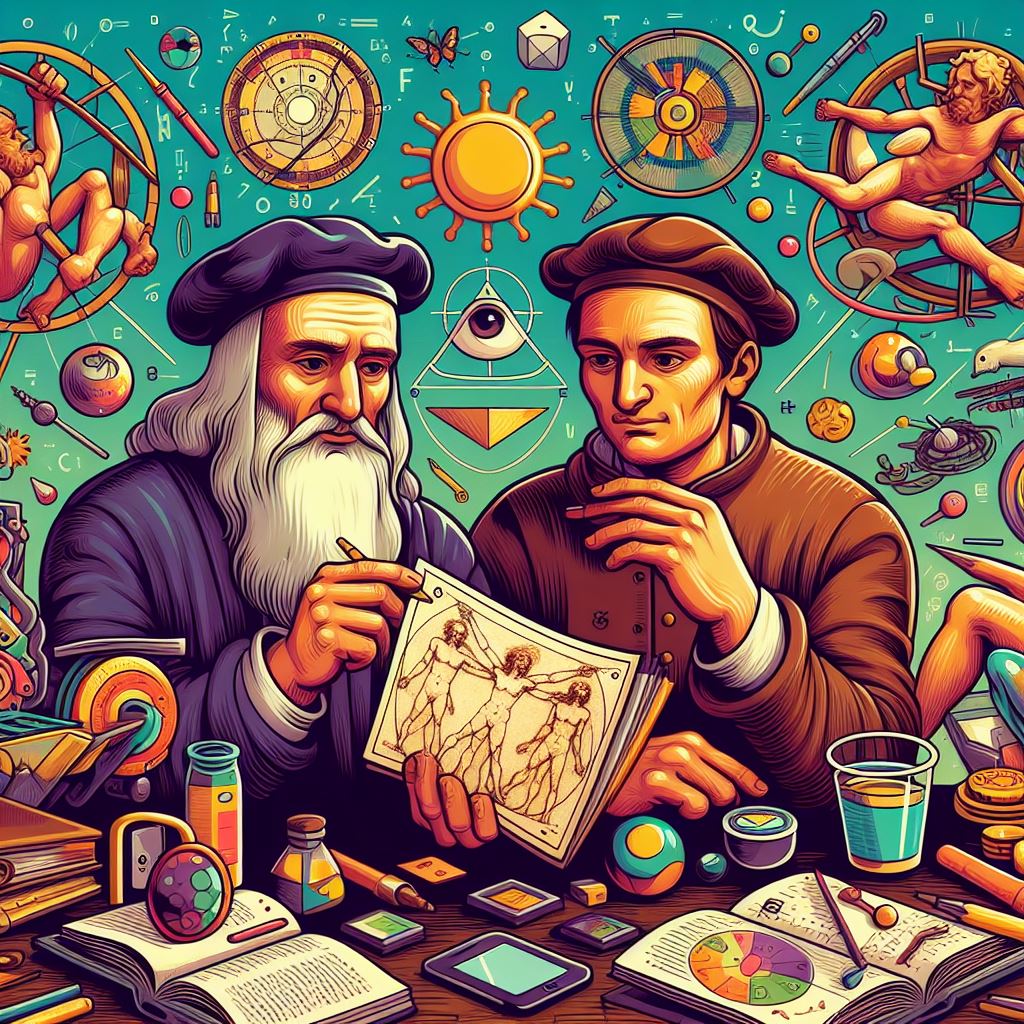The Renaissance era bridging 15th-16th century in Italy, marked by renewed interest in classical humanist knowledge and artistic naturalism, nurtured two colossal figures whose works profoundly influenced world art and culture for centuries – polymath Leonardo da Vinci (1452-1519) and sculptor/painter Michelangelo Buonarroti (1475-1564).
Dominating respective fields across anatomy, mechanics, hydraulics and optics for da Vinci and sculpture, painting, architecture and poetry for Michelangelo (Wallace 1994), both giants transformed approaches within their domains.

This ScienceShot analyzes the contrasting scientific and aesthetic values underpinning their oeuvres towards engineering and creative outputs.
Early Influences and Training
Both masters had an apprenticeship-style artistic education in Florence from a young age, absorbing established traditions while developing distinct talents and interests. Their temperaments, relationships with traditions, and relative privilege, on the other hand, exposed them to divergent formative influences.
Leonardo da Vinci (1452-1519) was born out of wedlock to a country notary and a peasant woman in the village of Vinci outside Florence (Capra, 2007). Lacking formal academic schooling, he trained under leading Florentine artist Andrea del Verrocchio from around age 15, learning skills of draftsmanship, painting, sculpture and metalworking alongside mathematics, geometry and Latin (Kemp, 2011). Da Vinci rapidly gained independent commissions and notoriety through his expressive paintings and ingenious inventions by early adulthood, securing elite patronage across Milan, Venice, and France over his career alongside scientific study (Capra, 2007). His empirical curiosity was evident in practical inventions, anatomical sketches based on dissections and desire to discern order behind nature’s complexity.
Michelangelo di Lodovico Buonarroti Simoni (1475-1564) was born to an established Florentine family of bankers and municipal administrators, enabling a privileged upbringing steeping him in humanist classics and Dante (Wallace, 1994). Unlike da Vinci’s eclectic learning, Michelangelo received relatively traditional literary schooling before apprenticeship around age 13 with leading painter Domenico Ghirlandaio, then in the Medici household gardens under sculptor Bertoldo di Giovanni (Hughes,1997). This focused foundation in drawing, modeling and carving absorbed existing conventions elevating naturalism and Greco-Roman ideals amid relatively staid patron expectations (Hughes,1997). Michelangelo then swiftly rose in notoriety for his emotionally charged, finely finished sculptures executed in solitude unlike collaborative frescoes. His lone genius persona masked profound talent despite reported melancholy and volatile moods.
Engineering Approach and Perspective
Inventions and proposed mechanisms in da Vinci’s notebooks suggest a systems thinking perspective seeking conceptual unification of phenomena related to flow, transformation, pressure and motion in the natural and built worlds to solve contemporary problems (Capra, 2007). A core goal involved explaining observable mechanics inductively in terms of components and fundamental forces still being quantified in his era preceding Newtonian physics.
Da Vinci moved easily across artistic commissions and scientific inquiry thanks to his aesthetic sensibilities honing form to function (Kemp, 2011). Creative diversity enabled contextual peripheral vision to reveal possibilities at the frontiers, while artisanal hands-on experimentation refined and synthesised new concepts for everything from canal locks and rapid-firing machine guns to winged human flight frames. His efforts to unravel and recreate nature's mysteries by mastering its functional processes fueled systematic creativity, bridging emergent engineering and lingering alchemical traditions, and paving the way for technological innovation long before formal disciplinary structure.
In contrast, Michelangelo approached creative works and occasional architectural or military commissions with intrinsic mastery aspirations leaned more individualistically on reinventing Humanist and Classical ideals in departure from prevailing conventions (Hughes, 1997). He focused maniacally on realizing the ineffably perfect sculpture or structure locked inviolate in his lone vision against external constraints, be they meddling patrons, assistant collaborators or the limits of current materials and methods (Wallace, 1994).
Through layers of overwrought sketches and repeated attempts to approach godlike creation by releasing pure imaginative ideals into stone and paint from his isolated vantage, the products often embodied tortured struggle amid poignant poetic power rather than da Vinci’s methodical unfolding of unifying natural mechanics and proportional beauty. Distilling from rather than integrating into broader contexts, Michelangelo’s masterpieces flowed from solitary obsession and introspective standards removed from worldly functional concerns or systematic threads beyond encapsulating the sublime and symbolic through human forms sculpted to perfection.
Representative Masterworks and Methods
Each giant carried core cognitive values into varied masterworks spanning from artistic commissions to civil and military engineering consultation or religious architecture and allegorical expressions of power and divinity. Underlying drives persisted throughout their creative journeys.
Da Vinci pursued reliable functionality seeking efficiency and resilience by studying biological and physical processes inductively for potential translation into technological application or prototyping innovations which sponsors could construct at scale. For instance, he analyzed avian wings across hundreds of species to discern relations between form, musculature and aerodynamics for potential human flight vehiclesyears before formulated airflow theories, while also sketching winged human contraptions alongside aerial screws for vertical flight prefiguring helicopters (Laurenza, 2019).
Before the engineering sciences matured, abstract relations shaped conceived machines as models for larger hydraulic systems and defence fortifications. Da Vinci created novel compositional spirals dynamically converging viewer attention in paintings of salvific religious scenes, or innovated sfumato smoky shading conveying elusive mystery behind his subjects' visages through pioneering optical experimentation with lenses (Kemp, 2011). He applied systematic governance principles to nature, machines, and aesthetics, aiming for generalised knowledge for practical creation or problem solving, even if constructs remained speculative given current construction capabilities.
Michelangelo declared sculpture and fresco painting to be tools for literally freeing idealised human forms innately sensed rather than empirically observed. He refused to copy any human model to create the Moses sculpture, instead carving variations from his marrow until emerging features radiated resolute wisdom and fiery anger as divinely "revealed portrait(s) of holy men from within stone by removing the stone veiling the image" (Hughes, 1997).
Unlike his subordinates who executed background details in frescoes to his prophetic vision, Michelangelo focused entirely on perfecting each sinew and limb of the heroic anatomies from Creation and the Flood upon the Sistine Chapel ceiling before attempting the allegorical Last Judgement scene behind the altar years later through his inner muse untainted by outside influences (Wallace, 1994), dismissing both patrons' opinions and Perugino's stylistic influences as irrelevant.
Through backbreaking solo work over years on scaffolding inches from the plaster, Michelangelo intensified symbolic expressions as spiritual catharsis channeling agonized tension between human potential and ignominy into each ripple and twist of his epic compositions. Raw torsion energy radiating across surfaces aimed to recreate his lonely exultation. Beyond transcendent moments captured, the obsessive master constrained by neither past conventions nor project timelines nearly always deemed efforts inadequate for the perfection eternally glimpsed in restless visions.
Discussion
Despite lack of formal mathematics or physics training during the pre-Scientific Revolution era, da Vinci formulated provisional theories on fluid dynamics, geology, optics and biomechanics through detailed observations, anatomical dissections and thought experiments which pioneering innovators like Copernicus and Galileo built upon decades later (Capra, 2007; Nuland, 2001). Rather than culminating Gothic trajectories at the Medieval era’s end, his empirical curiosity assimilated incipient humanism’s structured Greco-Roman ideals within overarching drives to discern orderly systems governing both craft and nature.
Thereby his art and engineering insights presaged interrelated Enlightenment trends seeking to taxonomically explain diverse phenomena through mechanical principles in the physical universe set in motion rationally by divine will as discovered retrospectively through scientific methodologies. Wide-ranging project designs addressed sponsors’ contemporary requirements yet often exceeded immediate feasibility to rather attempt prototype models of the adjacent possible from underlying root patterns discerned across macro and micro realms.
In contrast, Michelangelo resisted external constraints and forged tormented personal visions from the ascendant Renaissance humanist celebration of individual potential (Wallace, 1994), echoing predecessors like Giotto who similarly dismissed Medieval aesthetic hierarchies while catalyzing successive pioneers towards radical naturalism and emotive potency. His masterworks encapsulate the era both triumphing human dignity and wrestling to reconcile spiritual yearnings with rational rules, which Reformation and Counter-Reformation successors responded to differently across the maturing Baroque age as the Scientific Revolution brewed.
Michelangelo's recurring synthesis of human anatomy studies with mythic allegories and symbolic abstraction sought universality beyond direct naturalism, just as contemporaneous explorers expanded mental frontiers within historicizing moral narratives. Struggling mightily against the limits of each sculpture and wall to extract, reveal, and freeze exalted heights from the gross terrestrial plane, his masterpieces impel viewer emotions to soar beyond mundane confines through tortured muscular beings not yet free to float unencumbered towards sacred destiny. There are also unfulfilled promises from an era when bold individual vision began to challenge the constraints of church and state amid the tug of the past and the push of progress.

Conclusion
Finally, pioneering Renaissance luminaries Leonardo da Vinci and Michelangelo Buonarroti represent opposing approaches to creative innovation influenced by their respective orientations in relation to existing traditions during a period of growing naturalism. Da Vinci's artistic commissions combined emerging dynamics system thinking with exacting observations to explore and prototype technologies that represented human mastery over nature. Meanwhile, Michelangelo intensely expressed highly emotional human ideals in individual works, pushing contemporary style to extremes in order to liberate spiritual yearnings from worldly trappings.
Both mapped adjacent possibilities as the age's ruptures carved paths for future generations to follow out of Mediaeval order and into modernity. Their legacy exemplifies how individual genius reveals unseen realities by exploring nature's hidden patterns or through pure creative vision - heralding science and art's perseverance in revealing a limitless frontier.
References
- Capra, F. (2007). Science and da Vinci. Dotlet: Diaries of Talents and Their Likes.
- Hughes, A. (1997). Michelangelo. Phaidon Press Limited.
- Kemp, M. (2011). Christ to Coke: How Image Becomes Icon. Oxford University Press.
- Laurenza, D. (2019). Leonardo’s Flying Machines. Giunti Editore.
- Nuland, S.B. (2001). Leonardo Da Vinci. Penguin Books Limited.
- Wallace, W.E. (1994). Michelangelo: The Artist, the Man and his Times. Cambridge University Press.